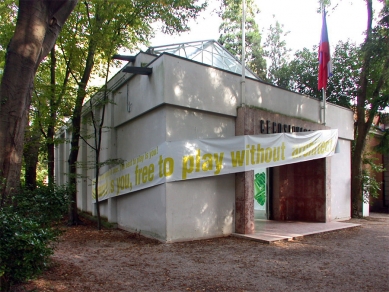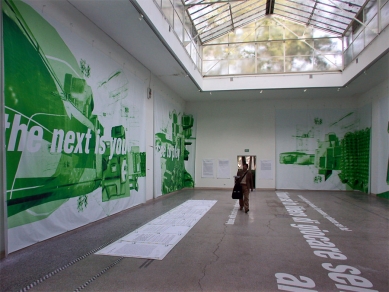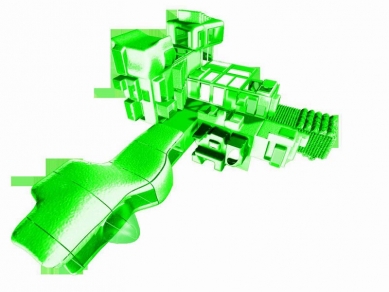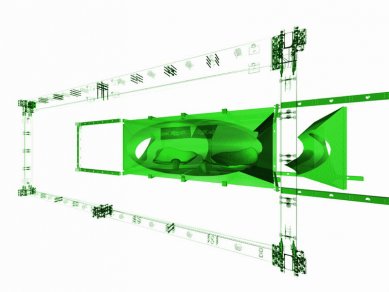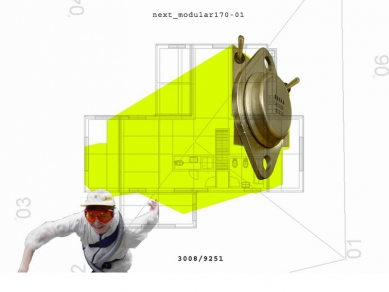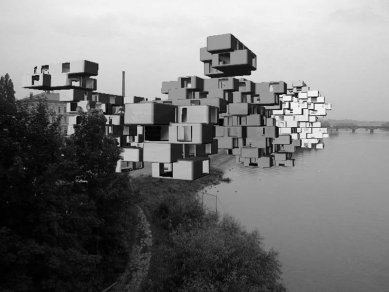
The future of architecture without architects
Exhibition of the Czech Republic and Slovakia at the 8th Architecture Biennale in Venice

Micro News
… cosmopolitan, organically growing, pre-nanotechnology spatial culture open to your personal taste, all influences … overcomes aesthetic interpretative prejudices of authors' censorship of form and is ready to serve its users directly, beyond external ethical aesthetic speculations … combines a composite orthogonal spatial skeleton with cyber-technology of dividing panels capable of producing original as well as series at the same price … liberates form and brings new methods into spatial creation such as scanning/copying/imitating, shifting parameters of imitated objects, transforming any digital information, for example recorded or composed sound into spatial form, smooth transitions as well as abrupt jumps in hardness/softness, porosity of texture and other conceivable surface parameters, etc. … everything is possible and everything is a contribution because it emerges from within in proportion to the individual utilized spaces … micro
A study of the open architecture/next
The study of building system combines prefabricated composite skeleton and recyclable polymer panels that are made with 3DPtm three-dimensional print technology.
The 3D panels enhance the process of developing new techniques, such as imitating your favorite existing objects, changing parameters, altering imitated objects, and so on. Technology that makes a prototype for the price of a mass-produced object will shift the economics of the system. The marketing strategy can offer the client (or developer’s client) participation in making the product and therefore the chance to co-develop the architecture that the client wants to use or own.
More freedom? More space? More options? Use this new technology and become the architect of your house!
1. Visit the system's virtual salesman on the web and get software to design your own house!
2. Visit the modular170 sample house!
3. Use the program to help you create your design within the spatial constraints afforded by the place you want to live!
4. Design the panels, or let architects design them for you, or choose from the catalogue!
5. Add or change panels of your house anytime!
It is ethical not to dictate anything!
The initiative of David Kopecký, Ján Studený, and their friends including Imro Vaško and Monika Mitášová grapples with a serious problem that could be labeled the end of architecture. Architecture perhaps deserves its end because many architects have lost the sense of ethics of their profession and succumbed to cynicism and commercialism. However, the thinking of our listed heroes revolves precisely around ethics. They believe that the essence of all architectural work up to today has resided in shaping constructions and images into which all previous societies have deposited their ideas of social order, hierarchy, cohesion, ideals, in short, ethics. However, modern society seems to them to be so loosened, and in a good, positive way, that it needs no architectural images of order anymore. Rather, such images are harmful. An architect who shapes, who tries to impose order on things, actually harms today’s democratic society. His only chance lies in the absence of shaping and “ordering.” When asked what the architect will still be good for, David Kopecký replied straightforwardly: “And who cares about it anyway.”
Let it be specific individuals who give “architecture” its form! No diktat, not even any architectural “idealization” of the client's character and taste, as once envisioned by the democratically inclined Frank Lloyd Wright, will have a place in today’s society! The architect will only present people with an absolutely flexible system, with which they will shape their own ideas of living or some other function. Such a system will not even be based on any solid module, also the “module” will inflate or shrink according to human wishes. Precedents of this program come to mind, the visions of avant-gardists of architecture as non-monumental, unshaped, unordered and thus also purely human instruments “without architecture,” the visions of Richard Buckminster Fuller or Konrad Wachsmann. They also envisioned their project like Kopecký, Studený, Vaško, Mitášová, of course at a lower technical level and with a lower attainability of absolute flexibility. However, it seems to me that it's not about the technique; it’s about the maximum narrowing of the architect's diktat, grounded in democratic ethics. I support the mentioned team and wish them to take their vision further than architects have so far.
… cosmopolitan, organically growing, pre-nanotechnology spatial culture open to your personal taste, all influences … overcomes aesthetic interpretative prejudices of authors' censorship of form and is ready to serve its users directly, beyond external ethical aesthetic speculations … combines a composite orthogonal spatial skeleton with cyber-technology of dividing panels capable of producing original as well as series at the same price … liberates form and brings new methods into spatial creation such as scanning/copying/imitating, shifting parameters of imitated objects, transforming any digital information, for example recorded or composed sound into spatial form, smooth transitions as well as abrupt jumps in hardness/softness, porosity of texture and other conceivable surface parameters, etc. … everything is possible and everything is a contribution because it emerges from within in proportion to the individual utilized spaces … micro
David Kopecký, ksa.
A study of the open architecture/next
The study of building system combines prefabricated composite skeleton and recyclable polymer panels that are made with 3DPtm three-dimensional print technology.
The 3D panels enhance the process of developing new techniques, such as imitating your favorite existing objects, changing parameters, altering imitated objects, and so on. Technology that makes a prototype for the price of a mass-produced object will shift the economics of the system. The marketing strategy can offer the client (or developer’s client) participation in making the product and therefore the chance to co-develop the architecture that the client wants to use or own.
More freedom? More space? More options? Use this new technology and become the architect of your house!
1. Visit the system's virtual salesman on the web and get software to design your own house!
2. Visit the modular170 sample house!
3. Use the program to help you create your design within the spatial constraints afforded by the place you want to live!
4. Design the panels, or let architects design them for you, or choose from the catalogue!
5. Add or change panels of your house anytime!
It is ethical not to dictate anything!
The initiative of David Kopecký, Ján Studený, and their friends including Imro Vaško and Monika Mitášová grapples with a serious problem that could be labeled the end of architecture. Architecture perhaps deserves its end because many architects have lost the sense of ethics of their profession and succumbed to cynicism and commercialism. However, the thinking of our listed heroes revolves precisely around ethics. They believe that the essence of all architectural work up to today has resided in shaping constructions and images into which all previous societies have deposited their ideas of social order, hierarchy, cohesion, ideals, in short, ethics. However, modern society seems to them to be so loosened, and in a good, positive way, that it needs no architectural images of order anymore. Rather, such images are harmful. An architect who shapes, who tries to impose order on things, actually harms today’s democratic society. His only chance lies in the absence of shaping and “ordering.” When asked what the architect will still be good for, David Kopecký replied straightforwardly: “And who cares about it anyway.”
Let it be specific individuals who give “architecture” its form! No diktat, not even any architectural “idealization” of the client's character and taste, as once envisioned by the democratically inclined Frank Lloyd Wright, will have a place in today’s society! The architect will only present people with an absolutely flexible system, with which they will shape their own ideas of living or some other function. Such a system will not even be based on any solid module, also the “module” will inflate or shrink according to human wishes. Precedents of this program come to mind, the visions of avant-gardists of architecture as non-monumental, unshaped, unordered and thus also purely human instruments “without architecture,” the visions of Richard Buckminster Fuller or Konrad Wachsmann. They also envisioned their project like Kopecký, Studený, Vaško, Mitášová, of course at a lower technical level and with a lower attainability of absolute flexibility. However, it seems to me that it's not about the technique; it’s about the maximum narrowing of the architect's diktat, grounded in democratic ethics. I support the mentioned team and wish them to take their vision further than architects have so far.
Rostislav Švácha
The English translation is powered by AI tool. Switch to Czech to view the original text source.
2 comments
add comment
Subject
Author
Date
safdie?-smutne retro
pavol
26.08.10 07:12
ŮPLNĚ MIMO
Jan Pavel
26.08.10 09:09
show all comments


